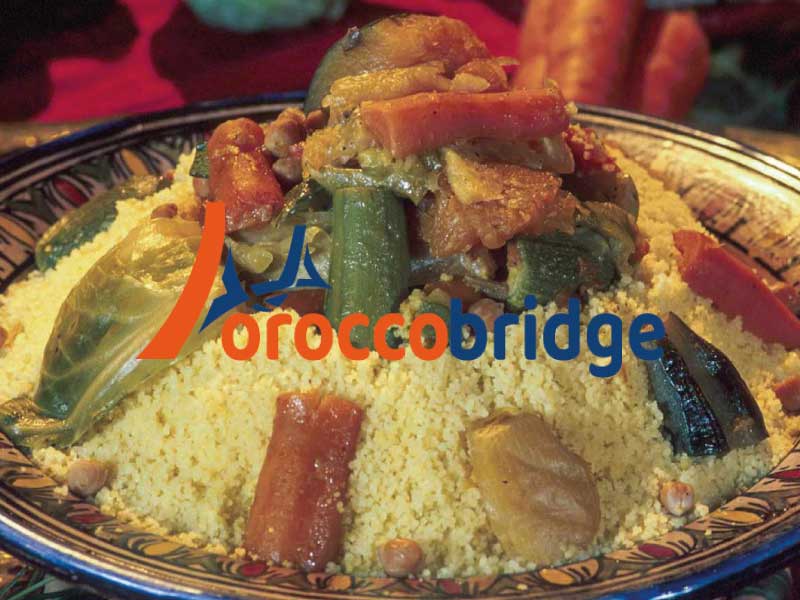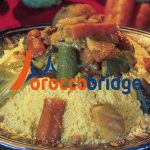Marrakech Couscous Friday: History and How to Cook It at Home – Couscous Friday in Marrakech is more than just a meal — it’s a deeply rooted cultural tradition that brings families together, honors centuries of history, and celebrates Moroccan hospitality. In this detailed guide, we uncover the rich history of Friday couscous, walk you through the authentic cooking method, and give you everything you need to recreate the experience at home, wherever you are.
The Cultural Importance of Couscous Friday in Marrakech
In Marrakech and across Morocco, Friday is a sacred day, comparable to Sunday in Christian-majority cultures. After Jumu’ah (Friday prayer), families gather to share a large communal dish of couscous, traditionally served in one bowl to symbolize unity, community, and blessing.
Couscous on Fridays is not only a religious and social ritual, but a culinary event that connects generations through a recipe passed down for centuries. It’s a time for slowing down, expressing gratitude, and connecting over food.
What Makes Marrakech Couscous Special?
Marrakchi couscous differs slightly from couscous in other regions of Morocco due to:
- Hearty use of vegetables: carrots, turnips, zucchini, pumpkin, and cabbage
- Aromatic spices: turmeric, saffron, cinnamon, and black pepper
- Tender lamb or beef simmered for hours
- Sometimes served with tfaya – a sweet onion and raisin topping caramelized with cinnamon and honey
The couscous grains are steamed multiple times over the meat and vegetable broth — never boiled — to produce a light, fluffy texture that is a hallmark of true Moroccan cooking.
How to Cook Marrakech Couscous at Home
Equipment
- 1 Couscoussier (Double Boiler Steamer)
- 1 Large Cooking Pot or Dutch Oven
- 1 Wide-Shallow Bowl (Gasâa)
- 1 Wooden Spoon or Silicone Spatula
- 1 Sharp Chef’s Knife & Cutting Board
- 1 Small Bowls or Spice Dishes
- 1 Clean Kitchen Towels
- 1 Small Saucepan (for Tfaya)
Ingredients
For the couscous base
- 500g fine couscous grains
- 3 tbsp olive oil or smen (Moroccan preserved butter)1 tsp salt
- 1 cup water
For the stew
- 500g lamb or beef (bone-in preferred)
- 2 onions (finely chopped)
- 3 carrots (peeled and halved)
- 2 zucchinis (cut into thick pieces)
- 1 small cabbage (quartered)
- 1 piece of pumpkin or squash
- 2 turnips
- 2 tomatoes (grated)
- 1 tsp turmeric
- ½ tsp black pepper
- 1 tsp ginger
- Salt to taste
- A few strands of saffron (optional but authentic)
- 1 bunch parsley and cilantro (tied together)
- 2 tbsp olive oil
- 1.5L water
Optional tfaya topping
- 2 onions (sliced)
- 1 cup raisins
- 2 tbsp honey
- 1 tsp cinnamon
Instructions
👨🍳 Preparation Instructions
- In a large couscoussier (or deep pot), heat olive oil.
- Add chopped onions and meat. Brown for 5 minutes.
- Stir in turmeric, black pepper, ginger, and saffron.
- Add grated tomatoes and parsley-cilantro bundle.
- Cover with water (~1.5L), bring to a boil, then reduce to simmer.
- After 30 minutes, add the vegetables starting with the firmest (carrots, turnips) and later softer ones (zucchini, cabbage, pumpkin).
Steam the Couscous
- Place couscous in a wide bowl. Moisten with a bit of water, 1 tsp salt, and 1 tbsp olive oil. Rub grains between hands to separate.
- Put in the top of the couscoussier, steam for 15–20 minutes.
- Return couscous to the bowl, sprinkle with salted water, fluff with fork or hands.
- Repeat steaming two more times (total 3 times), fluffing in between. After final steaming, mix with smen or butter for flavor.
(Optional) Prepare Tfaya
- Soak raisins in hot water.
- In a pan, cook sliced onions in a little oil until soft.
- Add drained raisins, honey, cinnamon, and simmer until caramelized.
Notes
Serving Marrakech Couscous the Traditional Way
- Pile the couscous in a large communal dish.
- Form a well in the center and ladle the meat and vegetables on top.
- Pour some broth over the grains — just enough to moisten without turning mushy.
- Top with tfaya if desired for that sweet-savory contrast.
- Serve with buttermilk (lben) or mint tea.
The Historical Roots of Couscous in Marrakech
Couscous originated in North Africa around the 13th century and has since become Morocco’s national dish. In Marrakech, it carries Berber, Arab, and Andalusian influences, making it a reflection of the city’s vibrant cultural fusion. Preparing couscous — especially on Friday — is an act of care, community, and legacy.Expert Tips for Perfect Couscous Every Time
- Never boil couscous – steaming makes it light and fluffy
- Use a couscoussier – essential for cooking grains above the stew
- Always fluff between steams – to avoid clumping
- Serve immediately – couscous tastes best fresh and warm
- Customize your veggies – depending on season and taste
Why Cooking Couscous at Home is a Must
Making Marrakech couscous at home is not just about the food — it’s about preserving a tradition, celebrating togetherness, and inviting the Moroccan spirit into your kitchen. Whether you’re feeding family or friends, this dish will nourish the soul and warm every heart at the table.Bring Morocco to Your Table
Cooking Moroccan couscous like in Marrakech isn’t just a recipe — it’s a cultural invitation. Every grain tells a story, every spice holds a memory. Whether you’re Moroccan or just discovering this cuisine for the first time, you’re taking part in something timeless and beautiful.
Important places to visit in Morocco:
- Rabat’s Best Beaches & Coastal Adventures
- Unforgettable Day Trip to Ouarzazate
- Hiking & Nature in Chefchaouen
- Essaouira: The Windy City’s Coastal Charm & Historic Medina



